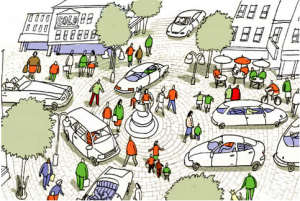Last weekend was the third annual Better World by Design conference, co-organized by an incredible team of students at Brown University and the Rhode Island School of Design. I was one of the original organizers in 2008. This year, I had the privilege of being able to sit back and watch.
Ben Hamilton-Baille started with the first presentation Saturday morning with a charming British accent and apologized for starting the day talking about traffic engineering and urban planning. The traditional approach to traffic engineering, he said, is to separate distinct forms of transport from each other and to regulate all of those forms with signage and signals, barriers, and markings on the road. Then by contrast, there is the ice skating rink, which, when it was first proposed, was a crazy idea – to fill a town center with ice and have people strap metal blades to their feet to glide across it seemed to be a recipe for disaster resulting in collisions and lost teeth. But people figured it out. When put into that situation, people demonstrated a complex set of social protocols to avoid collisions and flow smoothly around the skating rink. It was instinctive – like the behavior of schools of fish or flocks of birds. This is what he and other urban planners have proposed for town centers – to remove signage, signals, barriers, and markings, and to let pedestrians coexist with cyclists and motorists. I too thought it was a crazy idea at first, but the more videos I saw of it working, the more it made sense.
At this event, that’s what took place as well. In 2008, a few students had a big idea and worked to make it happen. We programmed every minute – our mistake was too much structure. But what we didn’t fully appreciate ourselves is that we already broke down traditional barriers in organizing this event. We had engineering students working with international development students and design students across two close but usually insular universities. None of us were doing it for credit or money – we just wanted to make something great happen. What we created was a skating rink of sorts that set the stage for keynote speakers, attendees, volunteers, and organizers to enter stripped of their egos and learn from one another in a way that seemed instinctive but somehow unlearned along all of our careers.
For more as it develops, have a look at the Better World by Design 2010 Flickr group.
